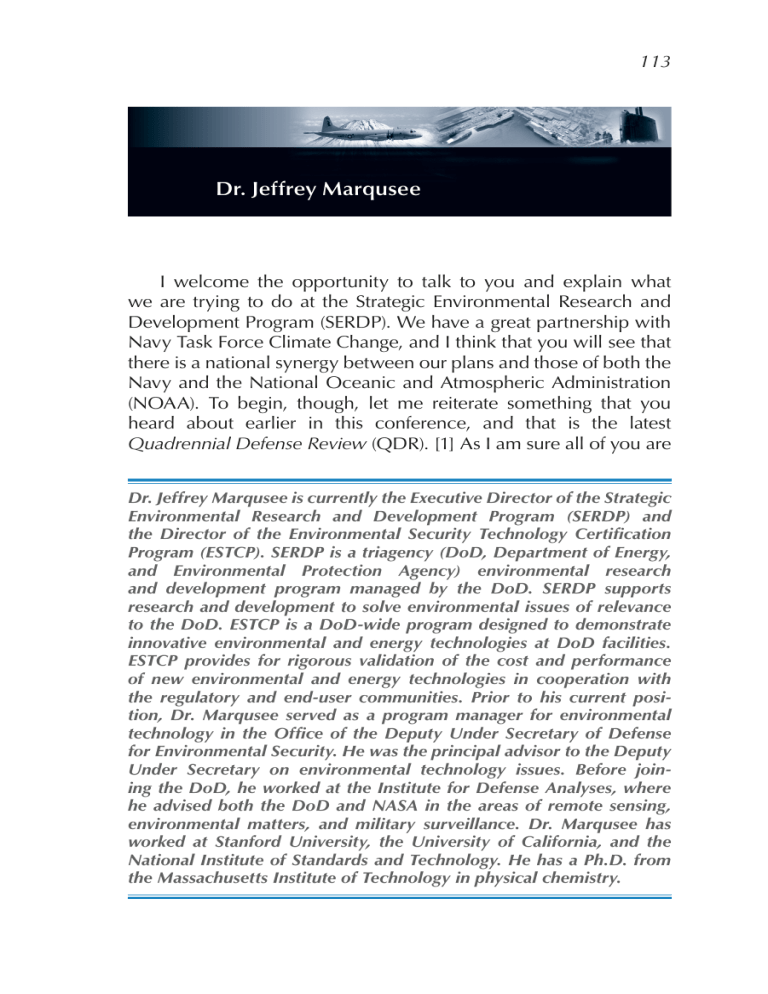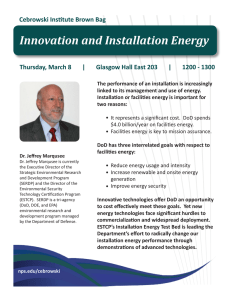Dr. Jeffrey Marqusee

113
Dr. Jeffrey Marqusee
I welcome the opportunity to talk to you and explain what we are trying to do at the Strategic Environmental Research and
Development Program (SERDP). We have a great partnership with
Navy Task Force Climate Change, and I think that you will see that there is a national synergy between our plans and those of both the
Navy and the National Oceanic and Atmospheric Administration
(NOAA). To begin, though, let me reiterate something that you heard about earlier in this conference, and that is the latest
Quadrennial Defense Review (QDR). [1] As I am sure all of you are
Dr. Jeffrey Marqusee is currently the Executive Director of the Strategic
Environmental Research and Development Program (SERDP) and the Director of the Environmental Security Technology Certification
Program (ESTCP). SERDP is a triagency (DoD, Department of Energy, and Environmental Protection Agency) environmental research and development program managed by the DoD. SERDP supports research and development to solve environmental issues of relevance to the DoD. ESTCP is a DoD-wide program designed to demonstrate innovative environmental and energy technologies at DoD facilities.
ESTCP provides for rigorous validation of the cost and performance of new environmental and energy technologies in cooperation with the regulatory and end-user communities. Prior to his current position, Dr. Marqusee served as a program manager for environmental technology in the Office of the Deputy Under Secretary of Defense for Environmental Security. He was the principal advisor to the Deputy
Under Secretary on environmental technology issues. Before joining the DoD, he worked at the Institute for Defense Analyses, where he advised both the DoD and NASA in the areas of remote sensing, environmental matters, and military surveillance. Dr. Marqusee has worked at Stanford University, the University of California, and the
National Institute of Standards and Technology. He has a Ph.D. from the Massachusetts Institute of Technology in physical chemistry.
114 Climate and Energy Proceedings 2011 aware, this is the first time that the most senior level in the department has set out a specific policy objective focused on responding to climate change. As part of that response, the QDR directed that the DoD conduct a comprehensive assessment for all installations of the potential impacts of climate change on its mission and identify any necessary adaptation. This is a pretty broad statement; initially, I do not think people recognized just how difficult the task would be. At present, there is not a timeline to accomplish that. I think that is both good and bad. I think it is good because it is a very tough job. On the other hand, not having a timeline means that you do not have the pressure or the budgetary support to get things done in a timely way. From our point of view, however, it is probably more important that we develop the right process and develop the right underlying science and technologies so we can do these assessments and enable future adaptation. The challenge of climate change is not something we are going to overcome this year, this next decade, or in our lifetimes. So, given the DoD’s responsibilities for managing its fixed installations, it is important that we establish a process through which the impacts of climate change can be included in the planning process. The Department has begun to develop that process, but it is a long way from being completed.
The first step in addressing this was to articulate in more detail what the QDR was talking about. The Strategic Sustainability Plan, which was signed out last year, describes a proposed multitier process for addressing climate change. [2] As part of that, we need to first develop the decision tools and the processes by which we assess impacts and vulnerabilities. After we have used those at the installation level, we can then develop robust adaptation plans.
According to the QDR, the research programs that I am responsible for were tasked with providing leadership for the overall effort.
While I was quite happy to take on that responsibility, I did not engineer its placement in the QDR. I first learned of the assignment when the QDR was published.
In our view, SERDP’s primary role in the DoD’s climate-related challenge is to understand the impacts to DoD installations and translate those impacts to vulnerabilities. In the future, we will
Chapter 4 Adapting Research to Climate Challenges 115 begin to look at adaptation schemes in a much more serious way.
Before we do that, though, we have to really understand what we are adapting to, what the stressors are, and what things are going to really impact our mission requirements. In looking at the DoD infrastructure, we need to look at both the built infrastructure—the
Department is responsible for over 300,000 buildings—as well as some 30 million acres of landscape. The Department is responsible for this landscape, both using it to conduct our training and testing missions and stewarding the natural resources included therein.
In addition, we use our installations as a power protection point. We have to be able to carry out our mission, whether it is from a harbor or from a desert location, from our installations.
They are critical to our warfighting capabilities. I am sure all of you in this audience are familiar with the litany of possible climate impacts to the DoD. Many of these are, of course, very regionally specific. The impacts you are concerned about on a coastal installation are qualitatively different than the ones applicable in
Alaska. They are qualitatively different than the ones that apply in the Southwest. However, they do have some commonality in that they are going to affect our built infrastructure in each of those areas. So, we have to know what we need to do to sustain that infrastructure. We need to know the key aspects of climate change that will impact our decisions on where we build our infrastructure and how we select the best sites for each of our missions.
And, as we develop our management scheme for natural resources in a stressed ecosystem, we have to accommodate the additional stressor of climate change.
From SERDP’s perspective, we try to avoid looking at climate change in isolation. It is one more significant and long-term stressor on a system that is already quite stressed. We are trying to identify ways to manage responses to all of those stresses. To do that,
SERDP has initiated a set of what I would call Regional Research
Programs that look at the major locations for DoD installations to get a sense of what the impacts are and what tools need to be developed. Down the road, we hope to hand the development of those tools over to groups like NOAA and the climate service.
116 Climate and Energy Proceedings 2011
Ultimately, we want to be able to use the data that they produce as we attempt to identify the DoD’s specific climate-related needs.
We are also starting a number of projects on the mitigation and adaptation side, although I am not going to focus on those today.
For the most part, they are currently concerned with energy use at our fixed installations. While that is obviously a significant concern,
I would like to focus more on the impact and vulnerability work that we have been doing. So, let me turn to the impacts of sea-level rise on our coastal installations. We have started a number of projects covering most of the major areas within the continental United
States that we think are likely to feel such impacts: Norfolk, Camp
Lejeune, the Gulf Coast, Tyndall Air Force Base, and Southern
California to include both Coronado and the Marine Corps base at
Pendleton. We initiated these studies some 2 years ago; they will be completed in another year. At that time, the information will be made available to the DoD and the public.
In conducting the assessment, we have tried to avoid predicting what future sea-level rise will be, but instead have employed a postulated set of scenarios. Thus, we are asking what would happen if the local sea-level rise was 1 meter, 1.5 meters, or 2 meters. In each case, we want to know what the impact would be on those installations. Many people think that sea-level rise is a simple phenomena to understand. We can all go to the Internet and call up simple maps of inundation. Unfortunately, that tells you very little about the actual problems that we will be facing. So, we are doing very detailed modeling using existing tools as well as building new models to look at the full range of dynamic impacts on these installations to include not only inundation but also such effects as storm surge, impacts to underground freshwater aquifers, and shifts in land cover. When we have completed the model runs, we need to translate the results into a form that means something to an installation garrison commander or one of the mission planners operating from that base. We need to be able to translate the information that you can get out of a local storm surge model into vulnerabilities for carrying out a missions. We also need to recognize that those vulnerabilities are not all for just one point in time. If you lose capability for X hours or Y weeks, what does that mean in terms of
Chapter 4 Adapting Research to Climate Challenges 117 overall mission execution? In the end we need to take the science of climate change predictions, translate that down to the regional or local installation level, and then translate that down to what a manager actually needs so he can plan and make his installation more robust.
We have started a number of projects looking at other regions that we think are going to be impacted in the near term. We are particularly concerned about issues in the Southwest, although our role at SERDP is not to augment or replace the predictive capabilities of organizations like NOAA, NASA, the National Science
Foundation, or the Office of Naval Research but rather to take the information they produce and translate it into impacts that our installation managers can use. In the American Southwest, it is clear that over the coming decades we are going to face a climate that is qualitatively different than what we have seen thus far. What does that mean for issues of fire frequency, the presence of invasive species, and the coupling between those effects? How will those factors affect our natural resource management for a system that is heavily dependent on the ephemeral stream flows? If we suddenly reach a situation where the many water bodies in the region are effectively disconnected for longer periods of time, how will that change the viability of endangered species that we are legally required to sustain? We need to develop the science and the tools both to develop new ways to manage that future as well as to inform the regulatory process so that we have requirements that we can manage toward. It does no one any good to set up regulatory requirements that cannot possibly be met. So, we really need to jointly understand what the future will look like and what our options are likely to be.
Alaska is yet another area where we are conducting research.
The DoD, predominantly the Army, has 1.5 million acres of critical training land in the central part of the state. Alaska is already undergoing significant climatic changes. The permafrost no longer seems to be permanent. Areas that we used to drive across in training are no longer frozen solid. Our whole understanding of the hydrology of that region was based on the belief that permafrost is permafrost. We do not even have the appropriate models that
118 Climate and Energy Proceedings 2011 will allow us to couple the changes in permafrost to the region’s hydrology. We have to understand the future. Are we going to be managing wetlands that are no longer wetlands? How does this couple to the health of the boreal forest? And how does that then translate back to our range managers who need to use this landscape to train troops while ensuring that the landscape remains healthy landscape? So, we have provided funding to Alaska’s universities, several federal laboratories, the U.S. Geological Survey,
NOAA, and selected service laboratories to try to really push our understanding of what is going on.
At this point, let me talk briefly about where we are going in the future. One of the big challenges that is out there is how to provide the information that our managers need. How do we develop the decision frameworks or tools that allow either a major command or an installation garrison commander to make decisions about the future? Over the next several years, we plan to initiate a series of pilot projects to explore this space. If you go to people who have responsibility for major DoD installations and ask them if they care about climate change the answer you will usually get is no. If you ask whether climate change will affect their mission, they will say no. However, if you translate that question to one that asks: does the weather impact your mission or does the availability of this research impact your mission, then they will say, “Yes, it is currently getting really tough.” So we need to figure out the specific information the group needs, translate that into decision tools, and then request that information from the science community.
While that community is making impressive gains, there is a big gap between being able to predict temperature or precipitation and providing information that tells someone whether or not their installation is vulnerable.
As I indicated at the beginning of my presentation, the QDR and the Strategic Sustainability Plan have imposed a requirement for all installations to look at the impact of climate change. While that is a straightforward statement, until we define that future scenario in specific terms, it is going to be very difficult for an installation to actually approach the problem. What future climate? As we have heard, there is enormous uncertainty on exactly what we will
Chapter 4 Adapting Research to Climate Challenges 119 be looking at 10, 20, or 50 years out. So, one of the things that the
Department has to identify in the relatively near term is the specific climate scenarios we should plan against. I think the Department is actually in a relatively good position to do this. We are not a regulatory organization. We have no authority on the civilian side.
We are only responsible for our military installations. We have a culture and a history of planning in the face of uncertainty. It is perfectly appropriate to look at the extremes; you just have to quantify in what way they are extremes. You have to lay out the possible futures so that you can look at your management options. It does not mean that you need to be robust in the face of every possible future. We need to advance the science and develop the right tools to enhance the management of our installations. By doing that, we will be playing a key role in developing the guidance for the services as we work together to accommodate climate change, whatever it looks like.
REFEREnCES
1. Department of Defense, 2010 Quadrennial Defense Review,
2010, http://www.defense.gov/qdr/images/QDR_as_of_
12Feb10_1000.pdf
.
2. Department of Defense, Strategic Sustainability Performance Plan
FY 2010, Public Version, 2010.

